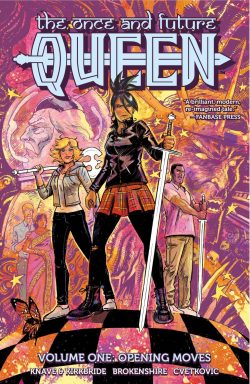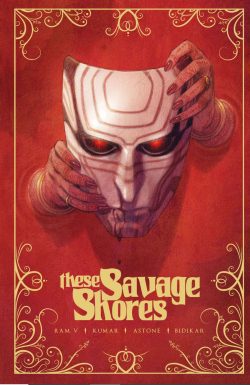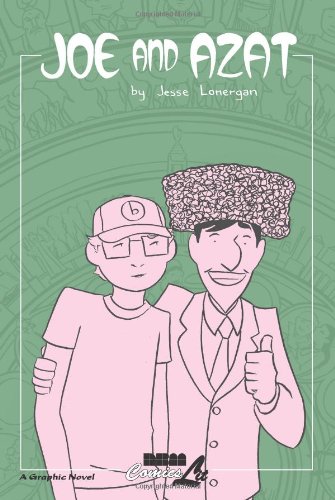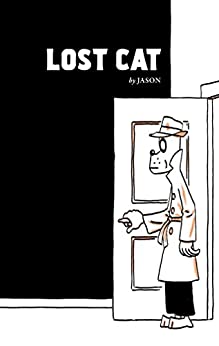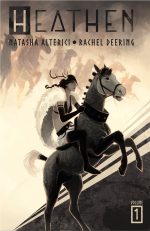
By Pete Milligan & Brendan McCarthy with Tom Frame (Vertigo/Little, Brown & Co)
ISBN: 978-1-56389-143-4 (Vertigo TPB) 1-85386-253-3 (Little, Brown PB)
It feels like a cop-out and total dereliction of duty, but none the less true that some graphic novels simply defy categorisation and defeat the reviewers’ dark arts: they just have to be read, experienced and judged on a personal basis. We could stop there and it’s over to you…
However, should you require more…
Rogan Gosh is a short serial by Pete (Skin; John Constantine, Hellblazer; Strange Days; The Human Target; Batman; Red Lanterns; Shade, the Changing Man; Enigma; The Extremist; X-Statix; Johnny Nemo, Bad Company) Milligan and Brendan (Dream Gang; Mad Max: Road Fury; Judge Dredd; Spider-Man: Fever; ReBoot; Zaucer of Zilk; Skin; Swimini Purpose; Strange Days; Sometime Stories) McCarthy with notable contributions from letterer/colourist Tom Frame.
It first appeared in short-lived, controversial, cutting edge, experimental British comic magazine Revolver – specifically issues #1-6 spanning July-December of the Fleetway Publication. It was later collected into a graphic album by DC/Vertigo in 1994. I’m pretty sure there was also a Fleetway collection, but if so, it’s nigh impossible to find now, and that was a lifetime ago, so I might be dreaming of another reality…
Like companion/precursor title Crisis, Revolver’s brief was to make comics for people who had outgrown funny picture stories and adults who claimed to have never read them. It was supposed to be political, fashionable, contemporary and contentious, and it succeeded over and over again, in strips like Dare, Purple Days, Happenstance and Kismet, God’s Little Acre, Pinhead Nation and Plug Into Jesus.
For many, the jewel in the crown was a bizarre and beautiful, sardonically surreal saga incorporating English curry houses, karmic renewal and exploration, science fiction iconography, cultural commentary and (in)appropriation, ferociously irreverent satirical comedy, and – apparently – concealed creator autobiography. It referenced Indian philosophy and religions, British colonial history and modern urban street life in an onrushing miasma of visual and ideological concepts that blew the mind and generated outrageous belly laughs. There were loads of guns and rockets and tons of sex too…
Like many Milligan & McCarthy creations the strip is often described as “post-modern psychedelia”, evolving from channelled childhood experiences of two white art school kids who had grown up amidst the burgeoning fallout of the Desi Diaspora. That’s when families from the countries of the Asian sub-continent – specifically Pakistan, Bangladesh and India – migrated to western countries like Britain, bringing new thought, music, fashions, scents and especially food to broaden and enrich an evolving multiculture. There were even comics unlike any we’d ever seen before when cruising the streets of Southall or Brick Lane…
Proud products of such an environment and rising superstars thanks to 2000AD, writer Milligan and co-plotter/illustrator McCarthy had planned to deliver a kind of “Bollywood Blade Runner”, but the story sort of got away from them… as is often the case with passion projects…
I’m feeling truly redundant trying to precis the plot, but for the sake of form, try this…
The universe exists on many levels and at all times. In Raj-era India Rudyard Kipling has shamed himself with a native houseboy and now roams the streets of Lahore, seeking a holy man to save his sanity and reputation by putting him in touch with the fabled Karmanauts.
His quest succeeds and the author is – via drugs and magic and ancient wisdom – elevated to a state where he witnesses a future where laddish London oaf Dean Cripps escapes stroppy girlfriend Mary Jane to go for a curry at the magnificent Star of the East in Stoke Newington.
When Dean feels a frisson of connection with beautiful waiter Raju Dhawan, the energy unleashes time-travelling wonder warrior Rogan Gosh just in time to defend enlightenment and all realities from the clandestine attacks of destructive Kali and her malign vampiric agent the Soma Swami…
It all gets a bit strange after that, what with audacious experimental love, devastation and recreation, Karma Kops, and that pest monkey god Hanuman, but rest assured that by the end, what you presume to be the regulation natural universe is back near where it belongs…
Although the story and events might bewilder, what is beyond question is the astounding art by Brendan McCarthy: utilising a blend of pen, paint and early digital technology to create a lush and vibrant homage to the startlingly bright colours of the subcontinent and plush décor of favourite London curry houses and tapping the wellsprings of a fevered and sublimely seasoned imagination to beguile the eyes. This stuff is just so damn pretty…
Hard to find in its original form, the entire trip is reprinted in 2013 anthology The Best of Milligan & McCarthy beside lots of other great stuff like Freakwave, Paradax! and Skin. The collection (which is on my to-do list…) is also available in digital format so there’s no need to wait.
Your destiny awaits, you only have to choose to embrace it…
™ & © 1990, 1994, 2013 Peter Milligan & Brendan McCarthy. All rights reserved.


